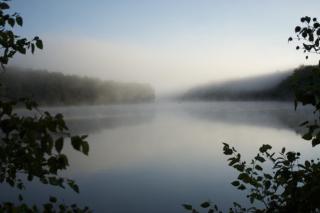About Lake Cochichewick

Background
Lake Cochichewick is the source of drinking water for the 28,000 residents of North Andover. At 560 acres, it’s the largest lake in Essex County, over twice the size of the local Merrimack College campus.
The lake and the surrounding water bodies were a major reason for early settlements in the area, with Cochichewick Plantation being chartered by the state in 1634. Settlement around Lake Cochichewick, which was colloquially known as Great Pond, began in the 1640s. The lake was popular for recreation then, as it is today. The lake is drained by the Cochichewick River, which passes through Stevens, Osgood, and Sutton Ponds before reaching the Merrimack River. As populations and industry grew in the region, these water bodies attracted mills and other businesses that would benefit from access to the water.
The Lake sits in a 2,700-acre bowl of land - the watershed - that drains into the lake. Near the airport, the watershed boundary is only seven hundred feet from the lakeshore. In other areas of the town, such as Barker and Bradford Streets, or Lisa Lane, or Coventry Lane, the watershed extends a full mile from the lake, draining down through many neighborhoods and into the lake through the ground, in runoff, streams, and wetlands.
About forty percent of the shoreline is conservation land, including Weir Hill, Osgood Hill, Half-Mile Hill and the Stevens Estate on the west side of the lake, and Mazurenko Farm to the north. This conservation land helps protect and filter water draining into this part of the lake. Large institutional landowners on the east shore of the lake include the North Andover Country Club, Rolling Ridge Conference Center, and Brooks School. There are 43 residential parcels on the lakeshore, and about 800 property parcels in the watershed.
Less than 1/3 of the water in the lake comes from rain falling directly onto the lake. The rest is surface runoff and water seeping through watershed soils into the lake (Source: IEP Watershed Plan pg 60). In other words, 2 out of 3 glasses of water from your home faucet is from runoff through neighborhoods in the watershed.
Because so much of the water we use for drinking from the lake drains over and through the surrounding land, the watershed around the lake has an important impact on the quality of the water source in the lake. Because of its importance, town bylaws require Special Permits for building in the watershed.
Water Quality
By 1986, many years’ worth of polluted runoff going into the lake from house construction, septic systems, and stormwater through the watershed resulted in the discovery of ‘giardia’ parasites in the lake water. This resulted in a ‘boil water’ order from the state and required the town to build a new water treatment plant at a cost of $19.9 million (Source: North Andover Open Space Plan).
In the early and mid-2000s, the Massachusetts Department of Environmental Protection and other entities conducted research in the watershed to assess the lingering impacts of industry and pollution in the region. While there were concerns about mercury and other pollutants in the watershed, the studies found significantly reduced levels of mercury in the Lake’s fish compared to historic levels.
Issues of pollutants continue, which has been shown by multiple cyanobacteria algae blooms since 2000, including one in summer 2020. Cyanobacteria are toxic and extremely harmful to humans or animals when ingested. A major cause of cyanobacteria blooms is fertilizer runoff and pet waste in the watershed. For these reasons, it is crucial that pet owners leash and pick up after their pets, especially in the watershed. Drinking water from the tap is treated and safe to drink, even during algae blooms.
The 2021 update to the Lake Cochichewick Watershed Plan will provide new insights and strategies for continued protection of North Andover’s drinking water and the watershed that surrounds it.
Watershed Management
In response to the 1986 Giardia outbreak, the town hired IEP, Inc. in 1987 to develop a Watershed Plan, analyzing the lake and watershed, and outlining steps to protect the drinking water supply. One strategy arising from the Watershed Plan was the creation of a Watershed Protection Overlay District. This zoning district restricts certain uses and activities in the watershed, in order to protect water quality and conserve the natural resources that support a healthy watershed. North Andover has taken an active effort in ensuring the protection of Lake Cochichewick.
In 1995, Town Meeting approved the purchase of the Stevens Estate and surrounding land on Osgood Hill, in order to protect these important resources and prevent harmful development in the watershed. In 1996, a Watershed Committee reviewed implementation of the 1987 Watershed Plan and the 1992 status report recommendations. The review included “appropriate use of the lake” and “in-lake management” including prohibition of gas engines, an algae monitoring program, and lake water sampling.
The Board of Selectmen established a Lake Access Committee in 2001 to draft regulations balancing recreation with use of the lake for drinking water and updated the regulations in 2016. Hand powered boats, as well as electric boats, are allowed on the Lake with either a day-permit or a lake use & boat storage permit issued by the town Department of Public Works. Boating is limited to Town residents with permits, and fishing requires a state fishing license


